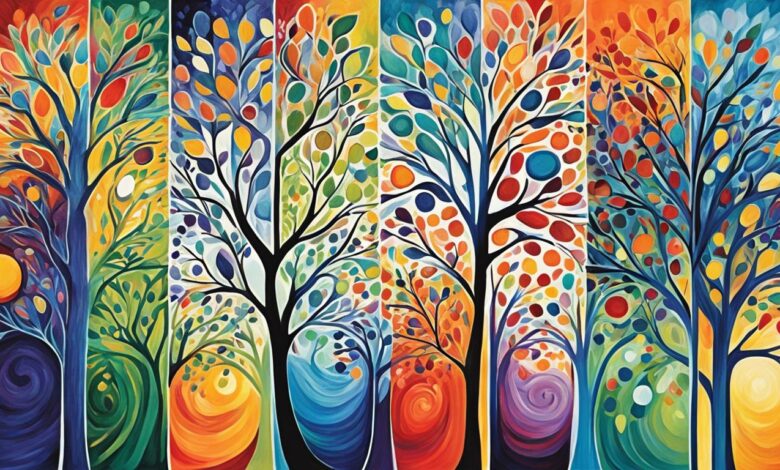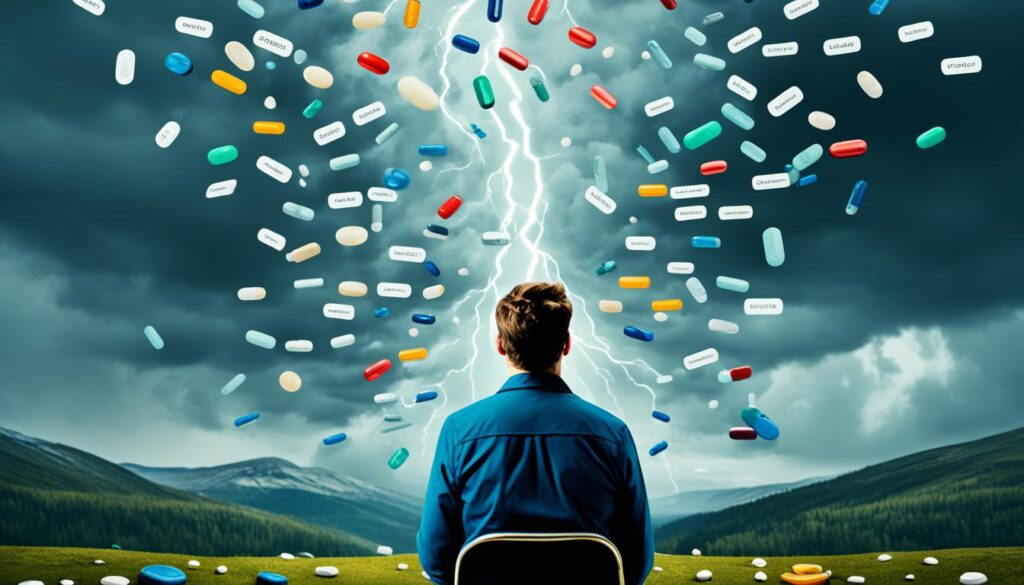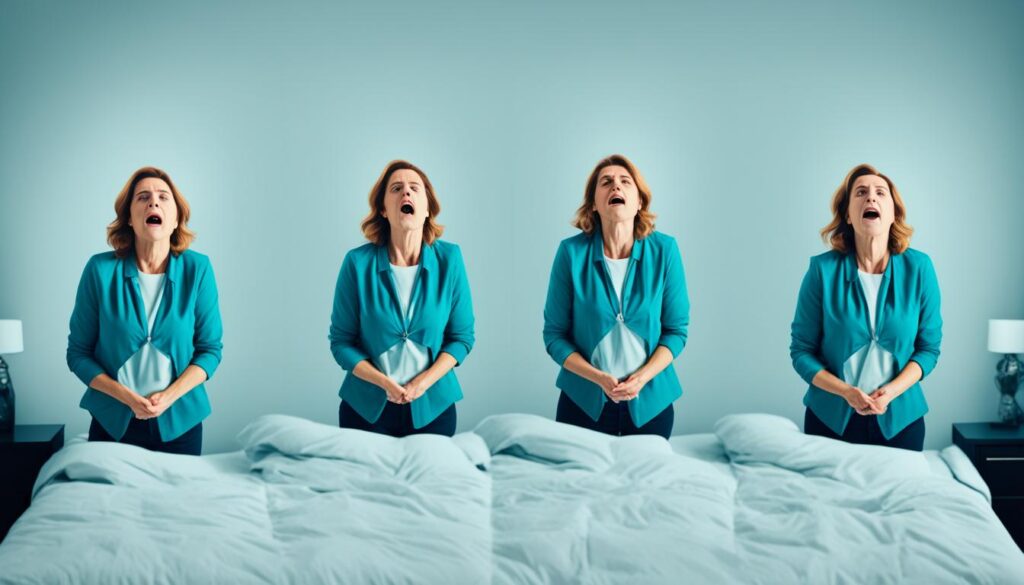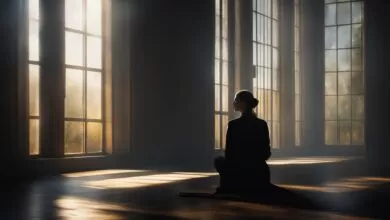Understanding Different Depression Forms

We often talk about ‘depression’ as if it’s one thing. But underneath this term, there’s a lot more. Knowing the Different Depression Forms helps us see the many faces of this condition. It’s not just about feeling sad. It’s about understanding the various Types of Depression that people quietly face every day.
Depression stories tend to mix different experiences into one. But we need to recognize these differences to help those in need. From major depressive disorder to the special issues of atypical depression, it’s key to know how these types vary. Most importantly, we need to find ways to help.
Our grasp of this mental issue has grown through personal stories and research. Still, the question remains: Can we fully understand the full range of What Are the Types of Depression?
Introduction: The Impact of Depression on Daily Life
Feeling sad at times is normal in life. But, when sadness becomes clinical depression, it’s a big problem. Depression’s effects are deep, making simple tasks feel impossible. It’s key to know there are different types of depression. Each affects people in its own way.
Clinical depression, or major depressive disorder, isn’t just feeling down. It changes how you think and stops you from enjoying life. It affects work, study, eating, sleeping, and socializing. This makes it different from just feeling sad sometimes.
Clinical depression starts because of a mix of social, psychological, and biological reasons. Things like money problems or breakups can trigger it. So can changes in the brain. Still, it’s often not recognized right, partly because people don’t always understand mental health well.
Beating clinical depression needs quick recognition and a full treatment plan. This includes medicine, talking treatments, and changes in how you live. The treatment must fit the person and the types of depression they have. This is key to getting better.
Dealing with clinical depression requires support and kindness. Health workers aim to help and build strength. By focusing on the impact of depression symptoms, we can aim for a future with better care. This future would be free from the stigma around mental health.
Recognizing Major Depressive Disorder (MDD)
Major Depressive Disorder (MDD) affects many people, lowering their life quality and functioning. It’s crucial to understand the Depression Symptoms and look into Treatment Options for MDD. Doing so can greatly improve one’s mental health.
Symptoms of Major Depressive Disorder
Depression Symptoms affect a person’s emotions and body in many ways. MDD can make someone feel sad or lose interest in daily life. For a diagnosis, one must have at least five symptoms for over two weeks. These can include problems sleeping, being very tired, feeling worthless, or thinking about suicide.
Subtypes of Major Depression
There are different types of MDD, such as anxious distress and melancholy. These types affect people in different ways. For example, anxious distress can make someone worry a lot, making daily tasks hard. On the other hand, melancholic depression can make someone find no joy in anything, even things they used to enjoy.
Treatment Options for MDD
Doctors usually suggest medicine and therapy to treat Major Depressive Disorder. The most common medicines are SSRIs and other antidepressants. If these don’t work, there are other options like Electroconvulsive Therapy (ECT), Transcranial Magnetic Stimulation (TMS), or Vagus Nerve Stimulation (VNS). These can offer hope to those struggling with MDD.
Understanding Persistent Depressive Disorder (PDD)
Persistent Depressive Disorder (PDD), also called dysthymia or chronic major depression, affects many over a long time. It brings a wide range of symptoms that can last for years. This condition deeply impacts people’s lives.
Comparing Dysthymia and Chronic Major Depression
In the discussion of long-lasting mood issues, we separate dysthymia from chronic major depression. Dysthymia shows milder symptoms that last long. On the other hand, chronic major depression has more severe effects.
Persistent Depressive Disorder sums up these two, showing both emotional and physical challenges. It might cause trouble with eating, sleeping, feeling tired, and focusing. Many feel a deep sense of hopelessness.
Managing Long-Term Depression
Dealing with long-term depression takes careful effort. For Persistent Depressive Disorder, the treatment uses therapy and medicine. The goal is to help people find ways to live better despite their symptoms.
Treatments like cognitive-behavioral therapy help change negative thoughts. Medications adjust brain chemistry. Handling Persistent Depressive Disorder, dysthymia, or chronic depression means staying committed to a plan. This plan should fit the person’s specific needs to improve their life.
Exploring the Highs and Lows: Bipolar Disorder
To really get Bipolar Disorder, we need to see how it flips between joy and sadness. It splits into Bipolar I and Bipolar II, each with its own struggles. Especially during the low points, which look a lot like severe depression.

Distinguishing Between Bipolar I and Bipolar II
Bipolar I means really intense mood highs. These can mess up daily life or even lead to hospital stays. On the other hand, Bipolar II involves milder highs but comes with heavy lows too.
Pharmacological Treatments for Bipolar Depression
For Bipolar Depression Treatments, mood stabilizers like lithium are key. They help smooth out the mood swings. There are special meds for the low moods in bipolar depression. Therapy is also suggested to help deal with this tricky condition. Doctors are careful with other meds, avoiding triggers for manic episodes.
Combating Seasonal Affective Disorder (SAD)
As winter days grow short, many of us battle the deep gloom of Seasonal Affective Disorder (SAD). It appears mostly in darker months, more severe than just “winter blues.” Knowing effective SAD Treatment strategies is key for finding relief from this recurring depression.
Light Therapy: A Bright Treatment for Dark Days
Light Therapy stands out as a leading way to fight SAD. It mimics sun’s light, aiming to reset our body clocks and boost spirits. By exposing oneself to a bright light box, it’s hoped to cut down melatonin levels, which could ease depression. Typically, this involves 30 minutes of light therapy each morning for most benefit.
Lifestyle Adjustments for Seasonal Depression
Besides light therapy, making some lifestyle changes can also ease Seasonal Affective Disorder symptoms. These acts, together with SAD Treatment, might help. See below for some helpful habits:
| Lifestyle Adjustment | Benefits for SAD |
|---|---|
| Maintaining a Regular Schedule | Helps regulate sleep and body’s clock |
| Exercising Regularly | Releases happy chemicals and boosts energy |
| Maximizing Natural Sunlight Exposure | Improves mood by increasing serotonin |
| Nutrition Rich in Vitamin D | Makes up for less sun and eases symptoms |
| Staying Socially Active | Lowers loneliness and lifts mood |
Each activity plays a role in tackling SAD, alongside light therapy or medical advice. Realizing and acting on these strategies can make winter much easier to handle.
The Complex Nature of Psychotic Depression
Psychotic Depression is a severe form of Major Depression. It combines usual depression symptoms with a twisted sense of reality. People may experience Hallucinations and Delusions, making it tough to treat. This complexity means doctors must use a mix of strong drugs to help.
People with Psychotic Depression feel very sad and hopeless. On top of this, they might hear voices or believe things that aren’t true. For example, they may think they’re being followed. These false beliefs can cause a lot of distress. They make the depression harder to deal with.
Treating this condition usually involves antidepressants and antipsychotics. Doctors try to ease the depression and stop the psychotic symptoms. If medicines don’t work well enough, they may use Electroconvulsive Therapy (ECT). ECT can be helpful for people deeply affected by Psychotic Depression.
With Psychotic Depression’s complex symptoms, treatment needs to be very thorough. A team of mental health experts must work together. They need to watch patients closely and adjust treatment when needed.
It’s crucial to understand how Psychotic Depression affects the mind and feelings. Knowing about the mix of Hallucinations, Delusions, and deep sadness is key. It helps in finding the best way to support someone dealing with this tough condition.
Postpartum Depression: Maternal Mental Health
New mothers often silently struggle with Postpartum Depression (PPD), a major concern in Maternal Mental Health. It’s more than just feeling down after birth; it’s a serious condition. Recognizing PPD is crucial for the timely support and care of new mothers.
Identifying Symptoms Beyond the “Baby Blues”
After having a baby, it’s normal for mothers to have mixed emotions. But, if severe mood swings, deep sadness, and extreme fatigue persist, it might be Postpartum Depression. These feelings go deeper than the short-lived “Baby Blues,” which fade within two weeks post-delivery.
PPD signs include losing interest in daily activities, feeling irritable, and struggling to connect with the baby. These symptoms can make it hard for a mom to take care of herself and her child.
Treatment Approaches for New Mothers
Treating Postpartum Depression usually involves antidepressants and therapy. Adding family therapy and support groups makes treatment even more effective. This mix of empathy, science, and healthcare guidance helps mothers through Peripartum Depression.
“What Are the Types of Depression?”
Depression comes in various forms, each marked by unique emotional, behavioral, and physical signs. The most common types are Types of Depression, Major Depressive Disorder, Persistent Depressive Disorder, Atypical Depression, Seasonal Affective Disorder, and Postpartum Depression. A mix of genetic, biochemical, and environmental factors influences these types.

Postpartum Depression affects new mothers and sometimes new fathers too. It causes intense mood swings, anxiety, and tiredness, making parenting harder. In contrast, Seasonal Affective Disorder (SAD) springs up with the changing seasons. It usually starts in the fall and lasts through winter, dampening energy and mood.
Atypical Depression is unique because good events can lift the mood. Yet, it often brings more eating, too much sleeping, and a deep fear of rejection.
| Type of Depression | Symptoms | Seasonal Pattern |
|---|---|---|
| Postpartum Depression | Sleep issues, strong mood swings, anxiety. | Occurs post childbirth. |
| Seasonal Affective Disorder | Lethargy, depression, withdrawal. | Common in fall and winter. |
| Atypical Depression | Mood reactivity, oversleeping, weight gain. | Non-seasonal, chronic. |
Every Type of Depression shows up differently and requires a specific way of treatment. Knowing the differences is key for the right diagnosis and personal care plans.
Targeting Atypical Depression: When Symptoms Diverge
Atypical Depression is often not well-understood. It shows symptoms that do not typically match the usual treatment methods. This disorder not only leads to a general feeling of sadness. It also reacts uniquely to happy moments, though briefly. Key signs are an unexpected boost in mood from good events, a need for more sleep, and a larger appetite. Other symptoms include leaden paralysis and a deep sensitivity to any criticism. It’s important to grasp the true nature of Atypical Depression for the right treatment approach.
The Role of Positive Events in Atypical Depression
Atypical Depression stands out because it allows brief mood boosts from positive events. This fact is key in both identifying the disorder and deciding on treatments. Creating a supportive environment for these positive moments can help. It works well alongside drugs in treating Atypical Depression.
Unique Treatment Considerations
In treating Atypical Depression, SSRIs are usually the first choice. However, when SSRIs don’t work well enough, MAOIs can be the answer. The table below lists the different aspects and uses of these drugs in treating Atypical Depression.
| Antidepressant Type | Considerations | Commonly Prescribed Medications |
|---|---|---|
| SSRIs | Generally well-tolerated, fewer side effects, considered first-line treatment. | Fluoxetine, Sertraline, Citalopram |
| MAOIs | Used as a second-line treatment, dietary restrictions required, effective for ‘atypical’ symptoms. | Phenelzine, Tranylcypromine, Isocarboxazid |
It’s vital for doctors to customize treatments for each person. They need to consider the specific signs and reactions of those with Atypical Depression. Understanding and addressing these unique needs, SSRIs and MAOIs both can be key in offering relief.
Addressing Depression in the Context of Stressful Life Events
Depression symptoms can come from a deep emotional reaction to big life stressors. Known as Stress Response Syndrome, it often starts after major events. These changes make it hard for people to adjust. At this point, psychotherapy becomes key. It provides the support needed to navigate through these changes.
Psychotherapy shines a light of hope. It tackles main depression symptoms. It also gives people ways to deal with their complex feelings. From cognitive methods to different therapy types, it’s all about helping patients face and adjust to their new situations.
| Life Event | Linked Depression Symptoms | Psychotherapeutic Approach |
|---|---|---|
| Family Death | Persistent sadness, withdrawal, loss of interest | Grief counseling, cognitive processing |
| Divorce | Anxiety, low self-esteem, hopelessness | Interpersonal therapy, narrative therapy |
| Job Loss | Insomnia, lack of concentration, fatigue | Strength-based therapy, solution-focused therapy |
Psychotherapy is flexible and personal in treating depression. It also helps people see the world differently after Stress Response Syndrome. Managing depression well means using a mix of care methods. The goal is to find emotional balance and build toughness.
“Psychotherapy is not just fixative; it’s transformative, offering a path to redefine one’s narrative after disruptive life events.”
In sum, psychotherapy is key for dealing with depression from life’s tough times. It helps people bounce back whether it’s from loss, divorce, or losing a job. It leads to healing and a fresh start for mental health.
Breaking Through Treatment-Resistant Depression
When depression doesn’t get better with usual treatments, it’s called Treatment-Resistant Depression. It’s tough but important to find ways to help. Looking into advanced treatments gives us hope for those dealing with this challenging condition.
Advanced Therapies and Experimental Approaches
Electroconvulsive Therapy (ECT) is a key option for people facing Treatment-Resistant Depression. Despite what movies show, ECT is safe and can be incredibly helpful. It works by causing a brief seizure in the brain with electric currents, which can quickly improve depression symptoms.
Other therapies like transcranial magnetic stimulation (TMS) and vagus nerve stimulation (VNS) are also being looked at. They’re for those who haven’t improved with usual treatments. These new methods are at the cutting edge of Depression Treatment, and research is ongoing to see how well they work over time.
Tailoring Strategies to Overcome Resistance
Treating Treatment-Resistant Depression has to be very personal since everyone’s different. Patients and doctors need to work closely to adjust the treatment plan as needed. Often, a mix of new meds, therapy, and other treatments works best.
Adding new therapy techniques and changing lifestyles can also make a big difference. This might mean testing to see how your body handles meds, having strong support from friends and family, or adding mindfulness and healthy eating to your day.
For those fighting Treatment-Resistant Depression, it’s a tough journey to feeling better. But with new treatments like Electroconvulsive Therapy and tailored care, there’s good reason to stay hopeful. Breakthroughs that bring relief are on the horizon.
Conclusion
In the world of Mental Health, depression isn’t just one problem. It comes in many forms. The journey to Overcoming Depression is complex. It requires tailored Depression Treatments. Changes in treatments are based on new findings.
Depression is complex and each type has its own challenges. To manage it, we must look at many factors like biology, history, and current situations. A flexible, informed approach is essential for effective treatment.
Helping those with depression is based on knowledge, kindness, and new therapy methods. Progress in this field brings hope to those affected. By focusing on each person and advocating for complete care, we aim for a future with less depression. This would make mental wellness more achievable for everyone.






